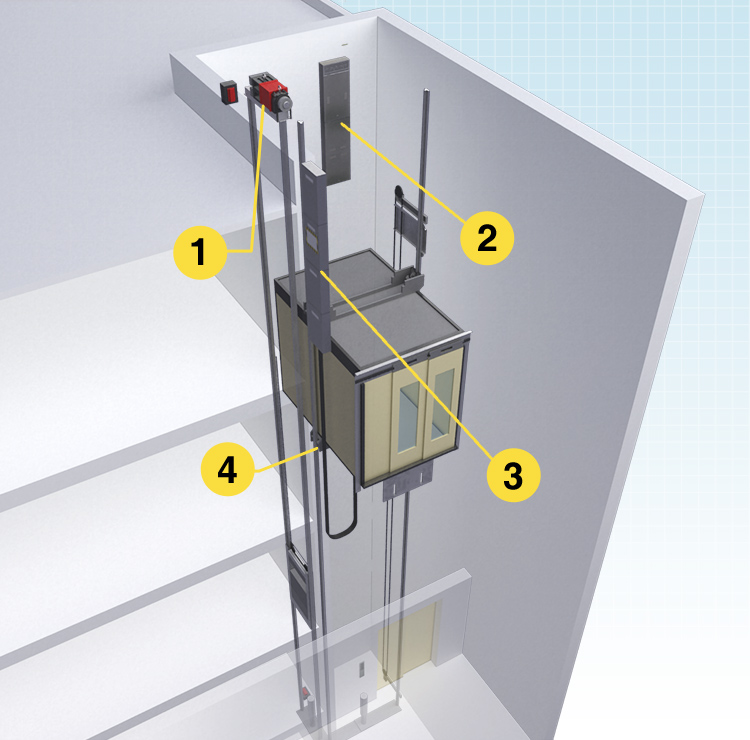Blog Single

When it comes to choosing the right elevator for your building, understanding the differences between machine room elevators and machine roomless elevators (MRL) is crucial. Each type has its unique advantages and applications, making it essential to evaluate your specific needs. In this blog post, we will compare and contrast these two elevator options, helping you make an informed decision for your property.
Overview of the Two Types of Elevators
Machine Room Elevators
Elevator machine rooms are traditional systems that require a dedicated space above or below the elevator shaft. This room houses the lift's machinery, including the motor, pulleys, and control systems. Machine room lifts are commonly used in highrise buildings and commercial properties due to their robust performance and reliability.
Machine Roomless Lifts (MRL)
Machine roomless lifts are a modern innovation that eliminates the need for a separate machine room. Instead, the machinery is integrated into the lift shaft itself, allowing for a more compact design. MRL lifts are increasingly popular in residential buildings and low to midrise commercial properties due to their space-saving features.
Advantages of MRL Lifts
1. Space Savings
One of the most significant advantages of machine roomless lifts is their ability to save valuable building space. Without the need for a dedicated machine room, MRL lifts can be installed in tighter areas, making them ideal for buildings with limited vertical space.
2. Energy Efficiency
MRL lifts are designed to be more energy efficient than traditional machine room lifts. They often use gearless traction systems, which consume less power and reduce operational costs. This energy efficiency not only benefits the environment but also lowers utility bills for building owners.
3. Quieter Operation
MRL lifts tend to operate more quietly than their machine room counterparts. The absence of a separate machine room reduces noise levels, creating a more pleasant experience for passengers.
4. Faster Installation
The installation process for MRL lifts is generally quicker and less complex, as there is no need to construct a separate machine room. This can lead to reduced construction timelines and costs.
Where Machine Room Lifts Are Still Necessary
Despite the advantages of MRL lifts, there are scenarios where traditional machine room lifts remain the better choice:
1. HighRise Buildings
For very tall buildings, machine room lifts may be more suitable due to their ability to handle higher loads and travel longer distances without compromising performance.
2. HeavyDuty Applications
In commercial settings where heavy loads are common, such as freight lifts or hospitals, machine room lifts provide the necessary power and reliability.
3. Customization and Control
Machine room lifts offer more options for customization and control systems, making them ideal for specialized applications.
Installation Costs and Maintenance Differences
Installation Costs
Machine Room Lifts: The installation of machine room lifts can be more expensive due to the need for a dedicated machine room and additional structural requirements.
Machine RoomLess Lifts: MRL lifts typically have lower installation costs, as they require less space and fewer structural modifications.
Maintenance Differences
Machine Room Lifts: Maintenance for machine room lifts can be more complex and timeconsuming, as technicians need access to the machine room for repairs and inspections.
Machine RoomLess Lifts: MRL lifts often have simpler maintenance requirements, as the machinery is located within the shaft. This can lead to quicker service times and reduced maintenance costs.
RealLife Examples of Applications
1. Residential Buildings
Many modern apartment complexes are opting for machine roomless lifts due to their spacesaving design and energy efficiency. These lifts provide residents with a smooth and quiet ride while maximizing usable space.
2. Commercial Properties
In low to midrise commercial buildings, MRL lifts are becoming increasingly popular. They offer a costeffective solution for businesses looking to enhance accessibility without sacrificing valuable floor space.
3. HighRise Developments
Traditional machine room lifts are still the preferred choice for highrise developments, where performance and load capacity are critical. These lifts are designed to handle the demands of tall buildings and provide reliable service.
Conclusion
Choosing between a machine room lift and a machine roomless lift depends on various factors, including building height, load requirements, available space, and budget. While MRL lifts offer significant advantages in terms of space savings and energy efficiency, traditional machine room lifts remain essential for highrise and heavyduty applications.
By understanding the differences and applications of each type, you can make an informed decision that best suits your building's needs. Whether you opt for a machine room or machine roomless lift, ensuring safety, reliability, and efficiency should always be your top priority.
